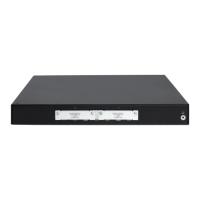25
Step Command Remarks
1. Enter system view.
system-view
N/A
2. Enter interface view.
interface
interface-type
interface-number
N/A
3. Enable Stac LZS
compression.
ppp compression
stac-lzs
By default, Stac LZS compression is
disabled.
Stac LZS compression takes effect on a
link only after you enable Stac LZS
compression at both ends of the link.
Outbound expedite forwarding is not
supported on links with Stac-LZS
compression enabled. Disable
outbound expedite forwarding before
performing this configuration.
Configuring VJ TCP header compression
VJ TCP header compression was defined in RFC 1144 for use on low-speed links.
Each TCP/IP packet transmitted over a TCP connection contains a typical 40-byte TCP/IP header
containing an IP header and a TCP header that are 20-byte long each. The information in some fields
of these headers, however, remains the same through the lifetime of the connection and will be sent
only once. In addition, although the information in some other fields changes, the changes are
predictable and are within a definite range. Based on such situation, VJ TCP header compression
can compress a 40-byte TCP/IP header to 3 to 5 bytes. It can significantly improve the transmission
speed of some applications, such as FTP, on a low-speed serial link like PPP.
To configure VJ TCP header compression:
Step Command Remarks
1. Enter system view.
system-view
N/A
2. Enter interface view.
interface
interface-type
interface-number
N/A
3. Enable VJ TCP header
compression.
ip tcp vjcompress
By default, VJ TCP header
compression is disabled.
Configuring LFI
CAUTION:
Disabling LFI also removes the configured maximum delay and size for LFI fragments.
Real-time packets such as Telnet and VoIP packets might be blocked or delayed on a low-speed
interface that is processing lots of large packets.
To reduce delays and jitters on low-speed links, LFI fragments large packets into small fragments.
The fragments are reassembled at the destination.
Figure 3 illustrates the LF
I process. When large packets and small voice packets arrive at an
interface that is enabled with WFQ, LFI fragments the large packets into small fragments, and adds
the fragments to the queues along with the voice packets.

